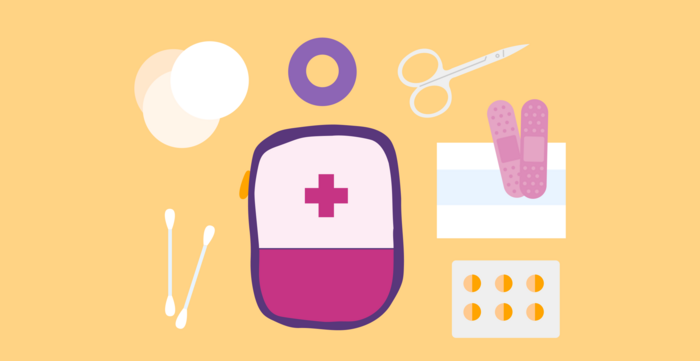
Feel better faster. Get care today.
From the clinic or your couch. Find high quality, same-day urgent care for you and your kids. Book an urgent care visit today.

There are two options here. You can either purchase an already-assembled first-aid kit (there are lots of options online) or you can easily make a first aid kit yourself. One benefit of a DIY first aid kit is that you can customize it to the size and health needs (or accident proneness) of your family. First things first, though. One of the most important parts of a first aid kit is the kit. As in, a one-stop-shop for all of your not-quite-emergency essentials, so you aren’t rifling through drawers and cabinets throughout the house trying to remember where you last saw those antiseptic wipes.
It doesn’t matter if your first aid essentials are in a box, a bag, a plastic case, or some other container, as long as your medical supplies are organized so you can find them easily. To make sure you have everything you need, the Red Cross provides a handy checklist of what a good first aid kit should include. Note that this list is for a family of four. If you have a larger family, you can use this as a reference point to figure out how much of each supply you should have on hand. If you’re a family of fewer than four, go ahead and follow the advised amounts—it can’t hurt to have extra. It’s also a good idea to create a first aid kit (containing the same items) for your car.
If you or a family member has specific allergies and needs an EpiPen, make sure you include that on your first aid kit checklist too. The Red Cross also recommends thinking through other personal items you may need, such as medications, the phone number of your family physician, local urgent care, or nearby family members who can help in case of a more serious injury or illness. If you are living with a chronic condition or other health concerns, check with your doctor to see if they recommend you include any additional items.
In addition to a first aid kit, it’s important to have a well-stocked medicine cabinet so you have the provisions to help alleviate minor colds, flus, viruses (like COVID), and other ailments.
If you haven’t updated your medicine cabinet in a while, first do an audit. Most medicines expire, losing their effectiveness. That means if you have old cough syrup lying around, it should probably be tossed. It’s a good idea to tend to your medicine cabinet regularly to make sure you have the following on hand (and that none of it has expired):
With a ready-to-go first aid kit and a stocked medicine cabinet, you’re ready to treat most minor illnesses and injuries on your own. But if you’re ever in doubt, Solv’s got your back. We offer telemed services in most states and have urgent care centers around the country—both convenient ways to get you back on the track to health.
Having a first aid kit at home allows you to treat minor injuries and illnesses immediately, reducing the need for unnecessary hospital visits.
Yes, you can create your own first aid kit. This allows you to customize it to your family's specific health needs and size.
Essential items include adhesive bandages, antiseptic wipes, a cold compress, non-latex gloves, and an emergency blanket among others.
It's important to regularly check your medicine cabinet to ensure all medicines are within their expiry date and necessary items are available.
Your medicine cabinet should include items like a working thermometer, a 30-day supply of prescriptions, painkillers, cough suppressants, antihistamines, and allergy medicines among others.
It is a good idea to regularly update your medicine cabinet. Most medicines expire and lose their effectiveness over time, so old medicines should be discarded and replaced.
If you have a chronic condition or other health concerns, you should consult with your doctor to see if they recommend you include any additional items in your first aid kit or medicine cabinet.
If you're ever in doubt about treating an illness or injury at home, you should seek professional medical help. There are telemed services and urgent care centers available in most states to assist you.

From the clinic or your couch. Find high quality, same-day urgent care for you and your kids. Book an urgent care visit today.